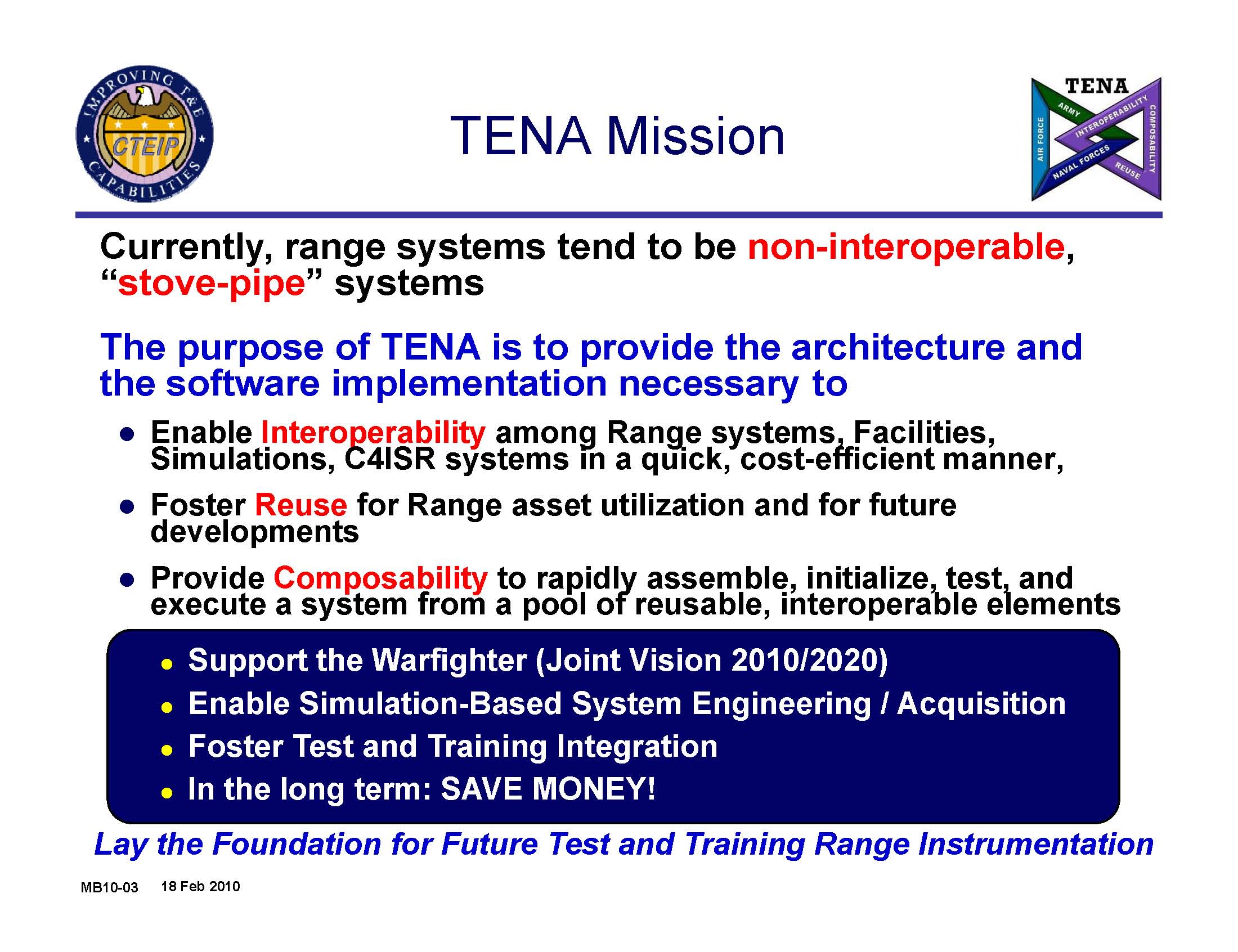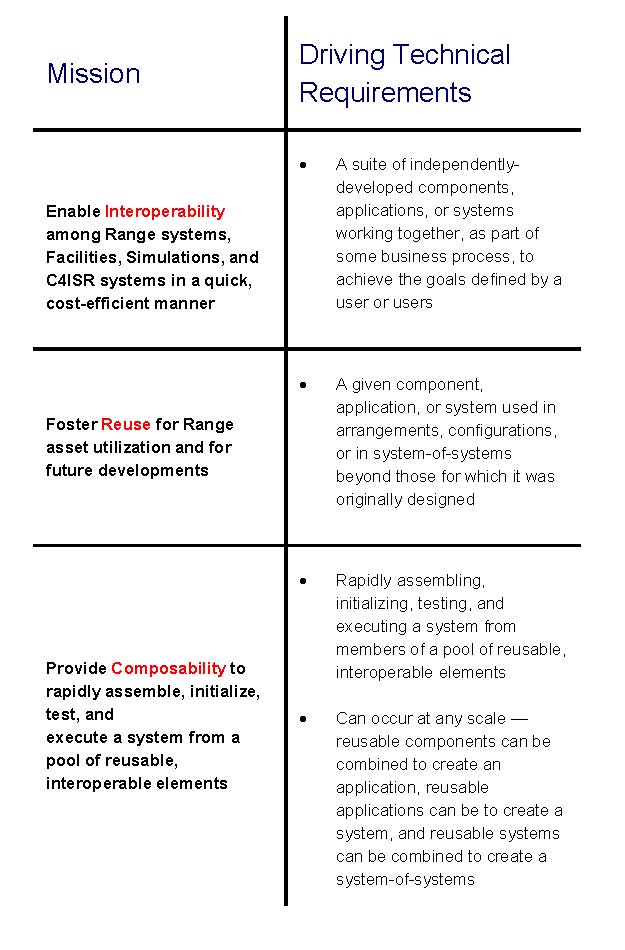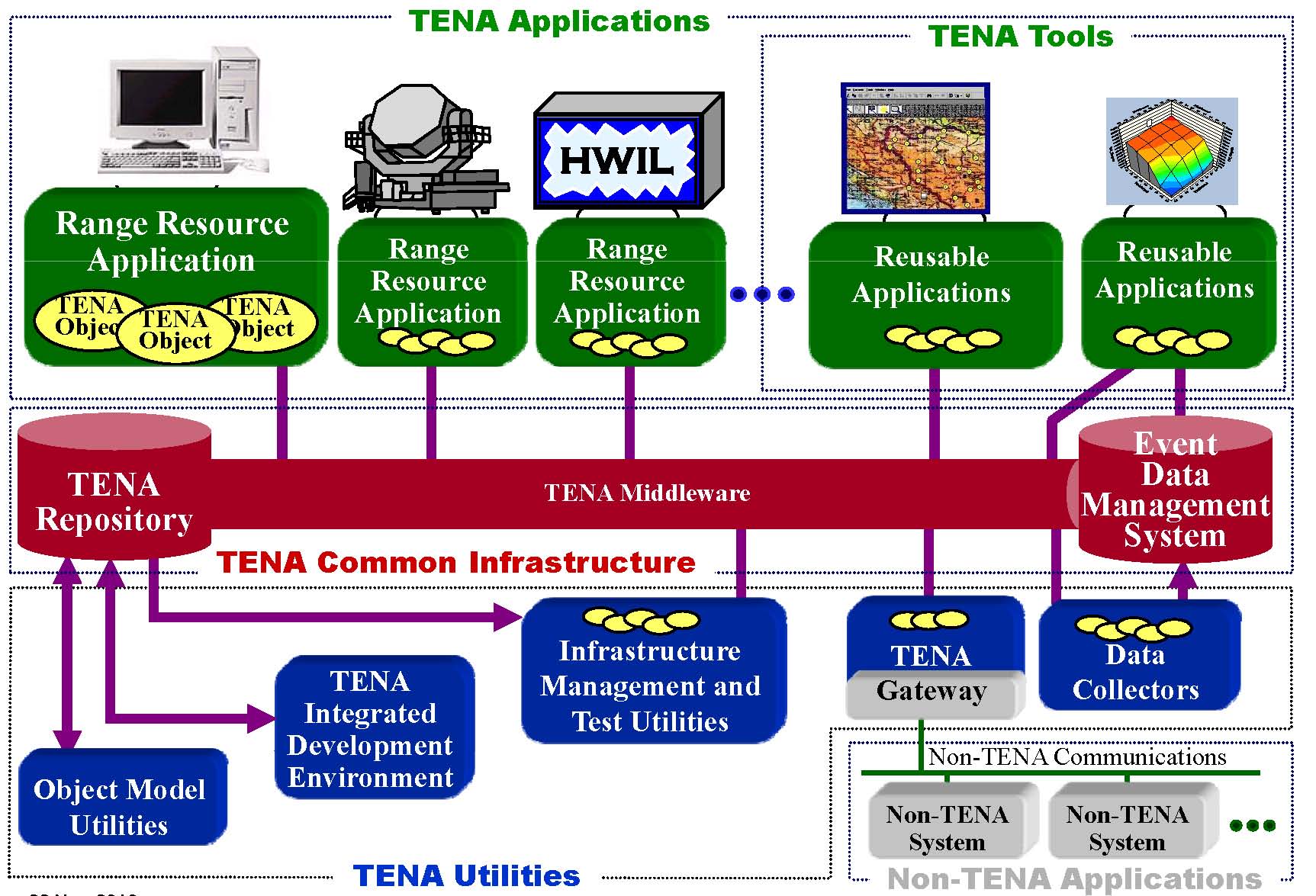Test and Training Enabling Architecture (TENA)
TENA Mission
The Office of the Secretary of Defense Test Resource Management Center Central Test and Evaluation Investment Program (CTEIP) is developing and validating a common architecture and requisite software to integrate testing, training, simulation, and high performance computing technologies, distributed across many facilities. Through the establishment of a common architecture, the Test and Training Enabling Architecture (TENA), reuse and interoperability of range assets will be tremendously improved, thus reducing range development, operation, and maintenance costs.
Requirement for TENA
While highly capable, the US Department of Defense (DoD) test and training ranges were created as “stovepipe” systems, built with different suites of sensors, networks, hardware, and software. The test and training events carried out at these facilities are varied in nature and range anywhere from individual systems under test to large-scale Joint exercises spread across numerous ranges where live, virtual, and constructive (LVC) systems are blended to enact representative scenarios. With the focus now on Joint Forces, the situation is changing to allow the most efficient use of current and future range resources (instrumentation, simulations, hardware-in-the-loop stimulators, C4I systems, display systems, etc.) from across Distributed ranges. To support the warfighting community, interoperability and reuse of resources within the test and training communities are needed to validate weapon system performance in a cost-effective manner. Cost-effective integration of range resources from test and training ranges is critical to test and determine the war worthiness of today’s advanced weapon systems and concepts.


Value of TENA
TENA promotes interoperability and reusability among DoD ranges, facilities, and simulations and advances a simulation-based acquisition or a "distributed engineering plant" methodology to streamline weapon system acquisition. Once the TENA capabilities are in use by the test and training communities, future inter-range operations, as well as instrumentation development and sustainment, will cost less and incur less risk. Most impressively, upgrading an existing range system to TENA takes only a few days, drastically shorter than traditional software integration efforts. Additional benefits from the TENA products include cost-effective replacement of unique range protocols, enhanced exchange of mission data, and organic TENA-compliant capabilities at test sites, which can be leveraged for future events.
TENA Products
The core of TENA is the TENA Common Infrastructure, including the TENA Middleware, the TENA Repository, and the TENA Object Models. The TENA Object Models define the common data and interfaces shared by all range applications. In addition, TENA specifies a number of tools, utilities, and gateways, enabling many range resources located at geographically dispersed ranges to be integrated together in a timely manner.
The TENA Middleware is the high-performance, real-time, low-latency communication infrastructure used by range resource applications and tools during the execution of a range event. All data exchange and control commands between range systems is accomplished by the TENA Middleware, which provides system developers with a unified application programmers interface (API) to support the real-time exchange of software objects, messages, and data streams (audio, video, telemetry, or tactical data links).
The TENA Object Model enables semantic interoperability among range resource applications by encoding all the information that needs to be communicated among those range applications. Quite simply, it is a range community-wide set of interface and protocol definitions encapsulated in an object-oriented design. As object definitions are proven to work in real-world range tests, they are standardized to be reused in future events. This prototype-based, iterative approach ensures that only object definitions with operational implementations are standardized.
The TENA Repository contains all the relevant TENA information that is not specific to a given test or training event, such as the software library containing the TENA Middleware, standardized range resource interface definitions, and executable versions of the TENA utilities and tools, along with related documentation. The repository is web-enabled and functions as a large database-of-databases, where event planners can browse and select existing range capabilities that can be easily configured and assembled to support an event.
The TENA Logical Range Data Archive stores and provides for the retrieval of all of the persistent information associated with a test or training event. The archive provides for the collection of data at multiple locations: in data storage devices local to each range resource application, on data collection systems running on separate computers that capture distributed range event information, and in a master database system that also contains scenario information as well as references to all the data collected for the particular event.
The TENA tools, utilities, and gateways assist the user in creating and managing an integration of range resources, as well as in optimizing the TENA Common Infrastructure. The core set of tools is a suite of key software applications for planning, configuring, controlling, monitoring, and analyzing synthetic and multiple range exercises. These TENA-compliant software tools enhance the range engineer’s productivity so that planning and reconfiguring many distributed range resources for large-scale synthetic exercises can be accomplished much faster and with higher reliability.
Progress and Completion
CTEIP has advanced the use of TENA by establishing a mutually supportive relationship with the Range Commanders Council so that TENA standards are reviewed and ultimately adopted by all of the ranges. TENA Middleware, currently at Release 6, is continuously tested at various ranges across the Services and has been successfully used in capabilities demonstrations and major military exercises.
TENA’s continuing development and refinement is managed by the TENA Software Development Activity (SDA), a DoD Test Resource Management Center (TRMC) office. The TENA Middleware is government owned, free and available for download, along with supporting documentation, at the TENA SDA web site (for registered users). The web site offers information, documentation and software downloads, a helpdesk, and on-line TENA event and training class registration.
Beyond the web site, TENA users and prospective users are further supported by a TENA SDA User Support team, which includes the functions of event design, event integration and coordination.
